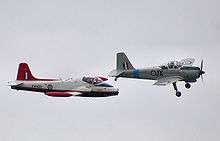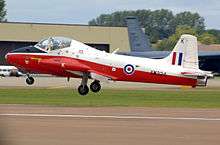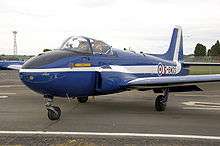BAC Jet Provost
| Jet Provost | |
|---|---|
.jpg) | |
| Jet Provost | |
| Role | Military trainer aircraft |
| First flight | 26 June 1954 |
| Introduction | 1955 |
| Retired | 1993 |
| Status | mostly retired, some examples flown privately[1] |
| Primary user | Royal Air Force |
| Produced | 1958–1967 |
| Number built | 741 |
| Developed from | Percival Provost |
| Variants | BAC Strikemaster |
The BAC Jet Provost (originally built by Hunting Percival) was a British jet-powered trainer aircraft used by the Royal Air Force (RAF) from 1955 to 1993. The Jet Provost was also successfully exported, serving in many air forces worldwide.
Design and development
In the 1950s the RAF issued a requirement for a new dedicated jet training aircraft. Hunting Percival developed the Jet Provost from the piston-engined Percival Provost basic trainer. On 16 June 1954, the prototype XD674 made its first flight from the factory at Luton Airport, flown by Dick Wheldon.[2] The Air Ministry ordered ten of the Jet Provost T1.

In June 1957, an order was placed for the first 40 of the developed Jet Provost T3, featuring a more powerful Armstrong Siddeley Viper jet engine, ejector seats, a redesign of the airframe, and a shortened and strengthened version of the retractable tricycle undercarriage. Percival built one example used purely for structural tests throughout the development stages, giving the designers valuable research into what could be achieved with the basic design. In total, 201 T3s were delivered between 1958 and 1962.

The T4 followed in 1960, fitted with a more powerful variant of the Viper engine and first flown on 15 July, and this was followed by the pressurised T5 in 1967.
The T51 was an armed export version, sold to Ceylon (Sri Lanka), Kuwait and Sudan. It was armed with two 7.7-mm (0.303-inch) machine guns. The T52 was another export version sold to Iraq, South Yemen, Sudan and Venezuela, with the same armament as the T51. The T55 was the final armed export version which was sold to Sudan.
A more heavily armed variant of the airframe was developed as the BAC Strikemaster.
Operational service



The Jet Provost proved to be a capable trainer. After successful acceptance trials of the T1 during late 1955 at No. 2 Flying Training School at RAF Hullavington, the RAF formally accepted the type in 1957. The first production version was the T3, powered by the Viper 102, and this entered service with No. 2 FTS, now relocated to RAF Syerston, during June 1959, when deliveries commenced from the Hunting Aircraft factory at Luton airport. The T3 was also operated by Central Flying School at RAF Little Rissington, the Royal Air Force College at RAF Cranwell, Lincolnshire, and by No. 1 Flying Training School at RAF Linton-on-Ouse, Yorkshire, 3FTS at RAF Leeming, Yorkshire, 6FTS at RAF Acklington, Northumberland, and 7FTS at RAF Church Fenton, Yorkshire.
The later T4 was fitted with the more powerful Viper A.S.V. 11 of 2,500 lbs static thrust and first flew on 15 July 1960. It quickly entered service with the units listed above.
The T5 variant was further developed and fitted with the Viper 201 and cockpit pressurisation. These developments encouraged the RAF to utilise the Jet Provost in a number of different roles besides basic training. With a top speed of 440 mph, excellent maneuverability, mechanical reliability and low operating costs, the Jet Provost was utilized as an aerobatic aircraft, air warfare and tactical weapons training as well as advanced training. The first T5 made its maiden flight on 28 February 1967 and deliveries from BAC's Warton factory commenced on 3 September 1969. Operators of the T 5 included the RAFs Central Flying School and No. 1, No. 3 and No. 6 Flying Training Schools.[3]
Besides service with the RAF, the Jet Provost found success in export markets. Jet Provosts were withdrawn from RAF service in the early 1990s and replaced by Short Tucanos. The Jet Provost remains popular among enthusiasts and being an inexpensive jet, many are now in private hands. Some are flown at airshows, whilst roughly equal numbers are maintained in ground runnable condition at various locations, mainly in the United Kingdom.
Variants
| Model | Number built | Manufacturer | Comments |
|---|---|---|---|
| Jet Provost T1 | 12 | Hunting Percival | Initial production batch for the RAF. |
| Jet Provost T2 | 4 | Hunting Percival | Development aircraft only. |
| Jet Provost T3 | 201 | Hunting Aircraft | Main production batch for the RAF. |
| Jet Provost T3A | (70) | Hunting | Modified T3 with improved avionics for the RAF. |
| Jet Provost T4 | 198 | BAC | Variant with more powerful engine for the RAF. |
| Jet Provost T5 | 110 | BAC | Pressurised version for the RAF. |
| Jet Provost T5A | (94) | BAC | Converted T5 with improved avionics. |
| (Jet Provost T5B) | (13) | BAC | Unofficial designation: a T5 fitted with tip-tanks used for navigator training. |
| Jet Provost T51 | 22 | Hunting Aircraft | Export version of the T3 (12 built for Ceylon, four built for Sudan, and six built for Kuwait). |
| Jet Provost T52 | 43 | BAC | Export version of the T4 (20 built for Iraq, 15 built for Venezuela, eight built for Sudan). |
| Jet Provost T55 | 5 | BAC | Export version of the T5, built for Sudan. |
| BAC Strikemaster | 146 | BAC | Ground attack version of the T5. |


Operators
- Royal Australian Air Force – A single T.Mk 2 was evaluated by No. 1 Basic Flying Training School RAAF for six months in 1959.
- Royal Ceylon Air Force received 12 T51s.
- Iraqi Air Force received 20 T52s, 15 of which survived the 1991 Gulf War.
- Kuwait Air Force received six T51s.j
- Portuguese Air Force received one T.Mk 2B in 1959.
- Republic of Singapore Air Force – 3 x T.52s (ex-South Yemen Air Force airframe) operated from 1975 until 1980.[4][5][6][7]
- South Yemen Air Force
- Sudan Air Force received four T51s, eight T52s and five T55s.
- Venezuelan Air Force received 15 T52s.
Specifications (T Mk. 5)
Data from Jane's All The World's Aircraft 1971–72 [8]
General characteristics
- Crew: Two
- Length: 34 ft 0 in (10.36 m)
- Wingspan: 35 ft 4 in (10.77 m)
- Height: 10 ft 2 in (3.10 m)
- Wing area: 213.7 sqft (19.80 m²)
- Empty weight: 4,888 lb [9] (2,222 kg)
- Loaded weight: 6,989 lb (3,170 kg)
- Max. takeoff weight: 9,200 lb (4,173 kg)
- Powerplant: One × Armstrong Siddeley Viper Mk-102 / Armstrong Siddeley Viper Mk-202 turbojet, 1,700 lbf / 2,500 lbf (8.1 kN / 11.1 kN) each
Performance
- Maximum speed: 440 mph (382 knots, 708 km/h) at 25,000 ft (7,620 m)
- Range: 900 mi [10] (780 NM, 1,450 km)
- Service ceiling: 36,750 ft (11,200 m)
- Rate of climb: 4,000 ft/min (20.3 m/s)
- Wing loading: 32.7 lb/ft² (160 kg/m²)
Armament
- Guns: 2× 0.303 in (7.7 mm) machine guns (Mark 55)
- Rockets: ** 6× 60 lb (27 kg) or
- 12× 25 lb (11 kg) or
- 28x 68 mm SNEB rockets in four pods
- Bombs:
- 4× 540 lb (245 kg)
See also
- Portal:British aircraft since World War II
- Red Pelicans
- Related development
- Aircraft of comparable role, configuration and era
- Related lists
References
- Notes
- ↑ Warbird Alley entry
- ↑ Flight International 13 June 1958, p. 795.
- ↑ Thetford, pp. 91–95
- ↑ UK Civil Aviation Authority Aircraft Register – Entry for former Singapore AF Jet Provost T52 registered G-PROV
- ↑ Andrade 1982, page 192
- ↑ History of G-PROV
- ↑ "Jet Provost T52 registered G-JETP." UK Civil Aviation Authority Aircraft Register. Retrieved: 3 July 2010.
- ↑ Taylor 1971, p. 181.
- ↑ "Hunting (BAC) Jet Provost" Warbird Alley. Retrieved 29 March 2009.
- ↑ with tip tanks.
- Bibliography
- Clarke, Bob. Jet Provost: The Little Plane With The Big History. Stroud, UK: Amberley Publishing Plc, 2008. ISBN 978-1-84868-097-5.
- "Jet Provost T.3". Flight International, Vol. 73, No. 2577, pp. 795–799.
- Taylor, John W.R. "Hunting Jet Provost and BAC 167." Combat Aircraft of the World from 1909 to the present. New York: G.P. Putnam's Sons, 1969. ISBN 0-425-03633-2.
- Taylor, John W.R., ed. Jane's All The World's Aircraft 1971–72. London: Janes's Yearbooks, 1971. ISBN 0-354-00094-2.
- Thetford, Owen. Aircraft of the Royal Air Force since 1918. Putnam & Company Limited. ISBN 0-370-10056-5.
External links
| Wikimedia Commons has media related to BAC Jet Provost. |
- The Jet Provost File: Individual RAF service histories
- Jet Provost heaven
- Warbird Alley: Jet Provost page
- "Jet Provost" a 1955 Flight article
| ||||||
| ||||||||||||||||||
